Top speed 578 km/h Retired 1971 Wingspan 55 m Engine type Pratt & Whitney T34 | Range 6,590 km Length 48 m Weight 49,630 kg | |
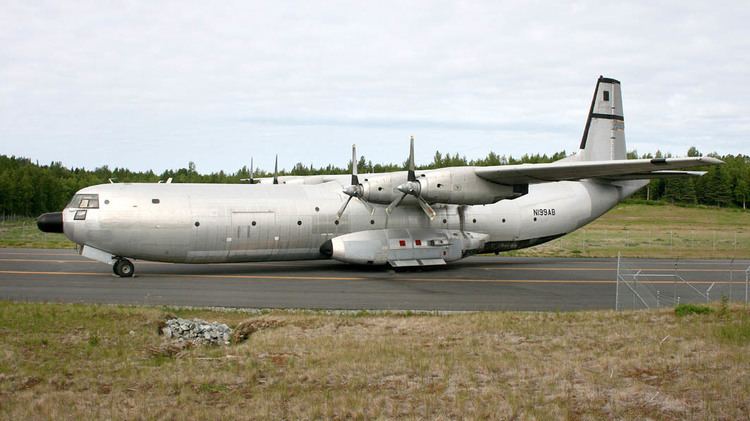 | ||
Douglas c 133 cargomaster 1956 newsreel
The Douglas C-133 Cargomaster was a large turboprop cargo aircraft built between 1956 and 1961 by the Douglas Aircraft Company for use with the United States Air Force. The C-133 was the USAF's only production turboprop-powered strategic airlifter, entering service shortly after the Lockheed C-130 Hercules, which was known as a tactical airlifter. It provided airlift services in a wide range of applications, being replaced by the C-5 Galaxy in the early 1970s.
Contents
- Douglas c 133 cargomaster 1956 newsreel
- Douglas c 133 cargomaster landing
- Design and development
- Operational history
- Operators
- Accidents and incidents
- Aircraft on display
- Specifications C 133B
- References
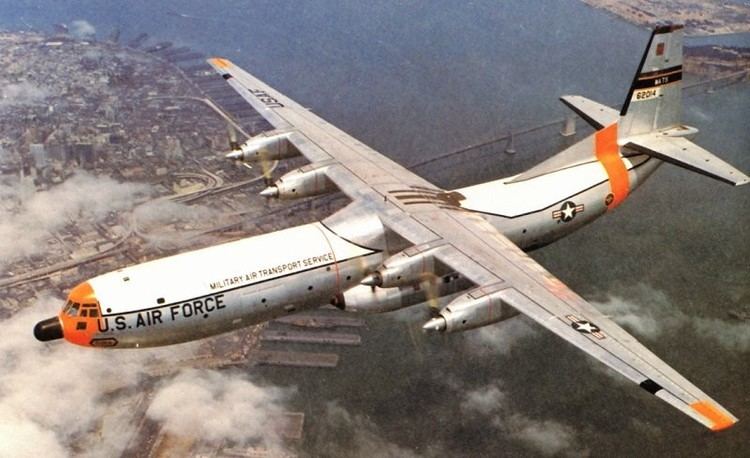
Douglas c 133 cargomaster landing
Design and development
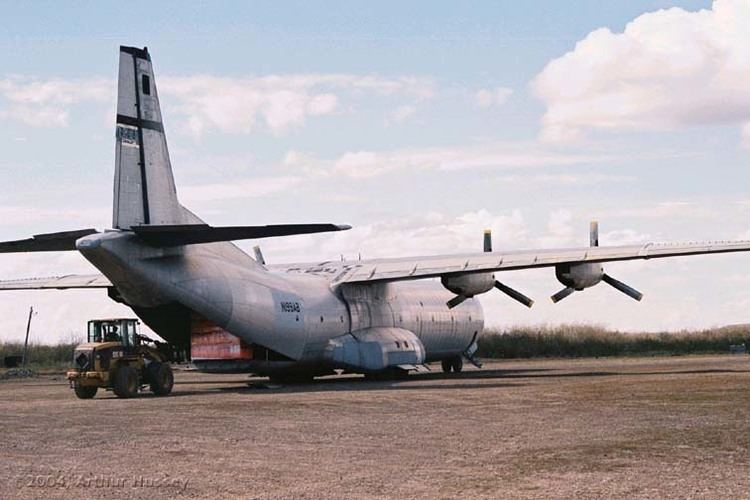
The C-133 was designed to meet the requirements for the USAF's Logistic Carrier Support System SS402L for a new strategic transport. The aircraft differed considerably from the C-74 Globemaster and C-124 Globemaster IIs that had preceded it. A high-mounted wing, external blister fairings on each side for the landing gear, and rear-loading and side-loading doors ensured that access to, and the volume of, the large cargo compartment were not compromised by these structures. The cargo compartment (90 ft/27 m in length and 12 ft/3.7 m high) was pressurized, heated, and ventilated.
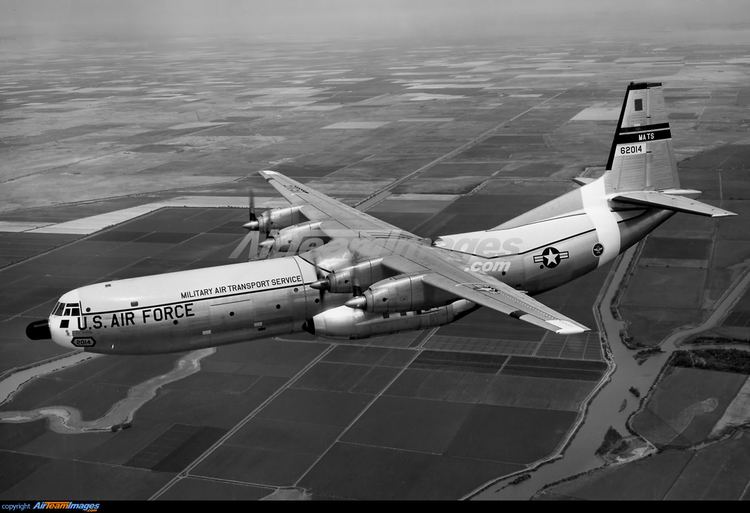
The Cargomasters went directly into production as C-133A; no prototypes were built. The first Cargomaster flew on 23 April 1956. The first C-133As were delivered to the Military Air Transport Service (MATS) in August 1957 and began flying MATS air routes throughout the world. Two C-133s established transatlantic speed records for transport aircraft on their first flights to Europe. The fleet of 50 aircraft proved itself invaluable during the Vietnam War. The Cargomaster soldiered on until the Lockheed C-5 Galaxy entered service in the early 1970s. The C-133 was then retired and most airplanes were cut up within months of being delivered to Davis-Monthan Air Force Base, Tucson, Arizona, after their final flights in 1971.
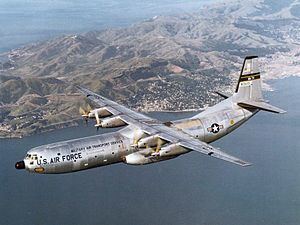
Fifty aircraft (35 C-133A and 15 C-133B) were constructed and put into service with the USAF. A single C-133A and a C-133B were built and kept at Douglas Long Beach as "test articles". They had no construction numbers or USAF tail numbers.
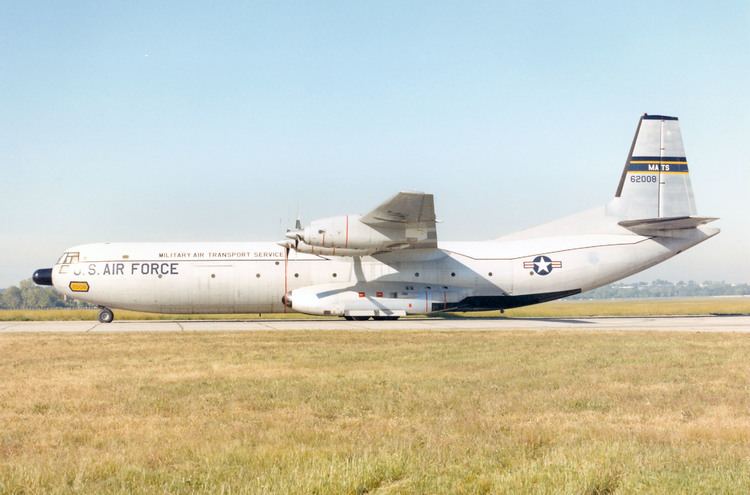
The C-133 had large tail doors and side doors and a large, open cargo area. With the C-133B, the rear cargo doors were modified to open to the side (petal doors), making an opening large enough to transport ballistic missiles such as the Atlas, Titan and Minuteman more inexpensively, safely and quickly than road transport. Several hundred Minuteman and other ICBMs were airlifted to and from their operational bases by C-133s. The C-133 also transported Atlas, Saturn and Titan rockets to Cape Canaveral for use as launch boosters in the Gemini, Mercury and Apollo space programs. After the Apollo capsules splashed down, they were airlifted in C-133s from Naval Station Norfolk, Virginia or Hickam AFB, Hawaii to Ellington AFB, Texas, or to California.
Operational history
The C-133 was for many years the only USAF aircraft capable of hauling very large or very heavy cargo. Despite the Douglas C-124 Globemaster II's capabilities, there was much cargo that it could not carry because of its configuration with a cargo deck 13 ft (4 m) off the ground and its lower, though substantial, engine power. The C-133 continued in service after the formation of the USAFs Military Airlift Command on 1 January 1966.
By 1971, shortly before the introduction of the Lockheed C-5 Galaxy, the Cargomaster was obsolete as well as being worn out, and all were withdrawn from service in 1971. The C-133 was originally a 10,000-hour airframe that had been life-extended to 19,000 hours. Severe vibration had caused critical stress corrosion of the airframes to the point that the aircraft were beyond economical operation any longer. The Air Force managed to keep as many of the C-133 fleet in service as possible until the C-5 finally entered squadron service.
C-133s set a number of unofficial records, including records for military transport aircraft on trans-Atlantic and trans-Pacific routes. Among the longest were non-stop flights from Tachikawa Airfield, Japan, to Travis Air Force Base, California (17:20 hours on 22 May 1959, 5,150 mi/8,288 km, 297.2 mph/478.3 km/h) and Hickam Air Force Base, Hawaii to Dover Air Force Base, Delaware in about 16 hours (4,850 mi/7,805 km 303.1 mph/487.8 km/h). The only FAI officially-sanctioned record was in December 1958, when C-133A 62008 lifted a payload of 117,900 lb (53,480 kg) to an altitude of 10,000 ft (3,048 m) at Dover Air Force Base, Delaware.
After retirement by the USAF, Cargomasters were operated by the Cargomaster Corporation in Alaska and by the Foundation for Airborne Relief based in California.
Operators
United States Air Force
Military Air Transport Service/Military Airlift Command
Source:
Accidents and incidents
The airplane developed a reputation of crashing early on in its life-cycle, crew members referred to it as a "widowmaker". Some would not fly in the C-133, since early on the cause of the crashes were unknown and it seemed airplanes were just falling out of the sky. A series of issues were discovered after several crash investigations. The first issue discovered, was with the auto-pitch controller on the propeller. A time delay was added to relieve stress on the nose casing. The second issue discovered was stall characteristics gave very little warning to the crew. The left wing was found to stall before the right wing. The fix was simple, a small strip of metal was attached to the right wing causing it to stall at the same time the left wing would stall. As the aircraft neared the end of its 10,000 hour life-cycle, on February 6, 1970 the last C-133B crashed. It was determined the airframe split at the cargo door. The final fix was a band around the airframe to strengthen, but the end of the C-133 was near. The C-5A Galaxy would debut in 1971 and mark the end of the C-133. Of 50 aircraft built, nine were lost in crashes and one was destroyed in a ground fire.
Aircraft on display
Specifications (C-133B)
Data from
General characteristics
Performance
